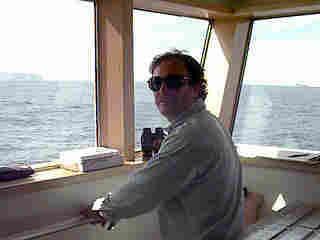29 January, 1998
Gould-en greetings!
Today has been "one of those days" in the life of a researcher working in a
hostile environment. Many pieces of equipment have ceased to function or
do so only erratically. They are still working out the bugs in the
electrical system of this new ship. We've had trouble with the power,
trouble with computers, and for a while at Palmer Station, the satellite
that we use for phones and email was in the shadow of the surrounding
mountains. Not good for communications. If anyone has sent email and did
not get a reply, it was because of the aforementioned problems. Please
send it again and I promise to reply.
The electrical problems have also affected our progress through the
research grid so those of you tracking us will see very little progress.
You might have even caught that we had to go back to Palmer station briefly
to pick up replacement equipment! Ah, yes, the pleasures of a maiden
voyage of a ship!
The one science that has not been plagued by problems is that of researcher
Peter Duley, who is one of a group of three who work with Bill Fraser on a
variety of pelagic (freely moving/open ocean) organisms. The reason Peter
has not been affected by all of these technical problems is because he
relies on his sight, enhanced only by binoculars. Peter is taking a census
(population count) of all seabirds and marine mammals encountered while we
make our way around the area. What are some of the birds you normally
associate with the coast and the sea in general? Some of the birds seen so
far are the blue-eyed shag (same family as USA's cormorants); light mantled
sooty albatross (large winged birds that soar effortlessly for days over
the ocean); south polar skuas (predatory gull-like birds); Adelie and
chinstrap penguins; and kelp or Dominican gulls.
The other parcticipants in Bill Fraser's group are Donna Patterson and Matt
Irienaga. Some of the things that they study are:
1) The reproductive success of penguins and how it may be related to the
tour industry is one part of the studies,. The good news is that
controlled tourist visitation does not seem to be affecting the
reproduction rate. This is probably due to the time of year they visit,
which is after the chicks have
hatched.
2) The health of the birds versus the advance and retreat of the sea ice
is also studied. When sea ice is
low due to warmer temperatures, more snow occurs because evaporation
off the ocean is greater.
Unfortunately, this is affecting the penguin populations negatively.
It appears the snow covers the
precious stones that form penguin nests so the birds must lay the eggs
in the snow. The snow melts
& the eggs in water do not develop. The summer is short, giving the
birds only one chance to raise a
chick per year. Added to the problem of the increased snow cover are
elephant seals, which have
increased in numbers. The big beasts do not eat penguins, but they
come ashore and lay where the
penguins nest, crushing the eggs and nests. Over the past 15 years,
the Adelies have gone from 9,000 breeding pairs down to 5,000. What
percentage of the population 15 years ago is still in
existence?
3) Predators of penguins are studied. These would include skuas, leopard
seals, and giant petrals
(birds that fly low over the water). What other marine mammal that is
associated with Antarctica eats
penguins? It isn't the humpback whale, because it filters small
organisms like krill (a small shrimp-
like crustacean) for food.
It would seem that they have a lot to study! It is through efforts like
these scientists that we can learn what processes help or hurt organisms.
What animals or plants that you know are having a hard time staying in
existence? What do we call organisms that no longer have any live
representatives?
If you would like a list of all the birds that Peter Duley has seen so far,
or if you would like to know the answer to any of the questions I've asked,
just write to me, either in care of the address on the Teachers
Experiencing Antarctica web site or to dawsonbe@lmg.polar.org.
Warm regards,
Mrs. D
PS: It is 41 degrees outside today and nice and sunny!

Contact the TEA in the field at
.
If you cannot connect through your browser, copy the
TEA's e-mail address in the "To:" line of
your favorite e-mail package.
|
